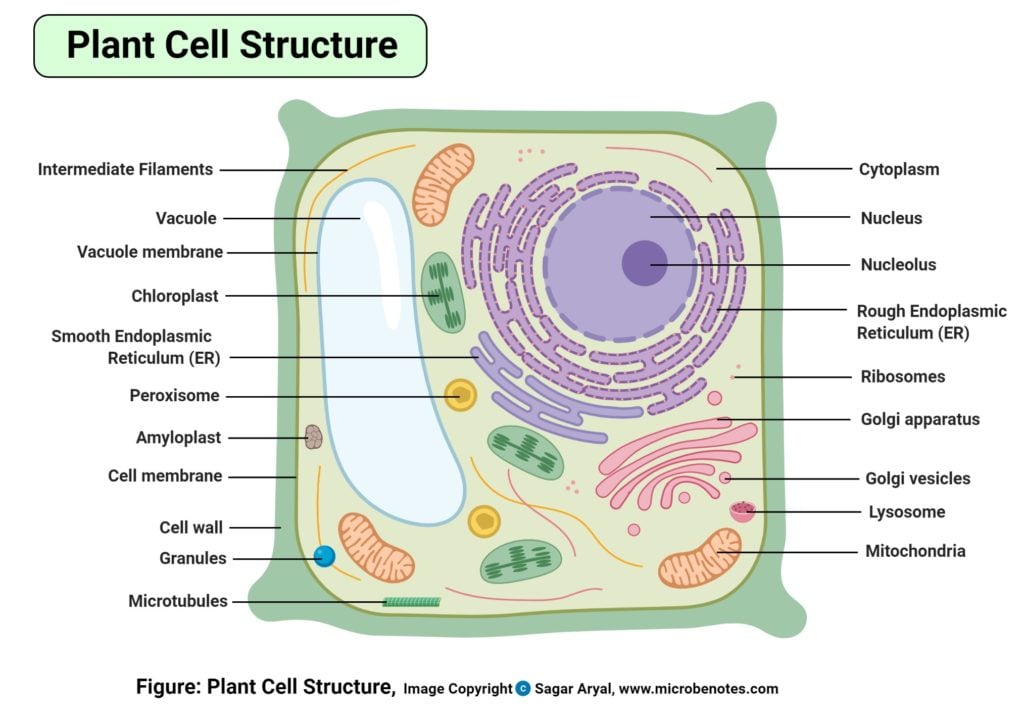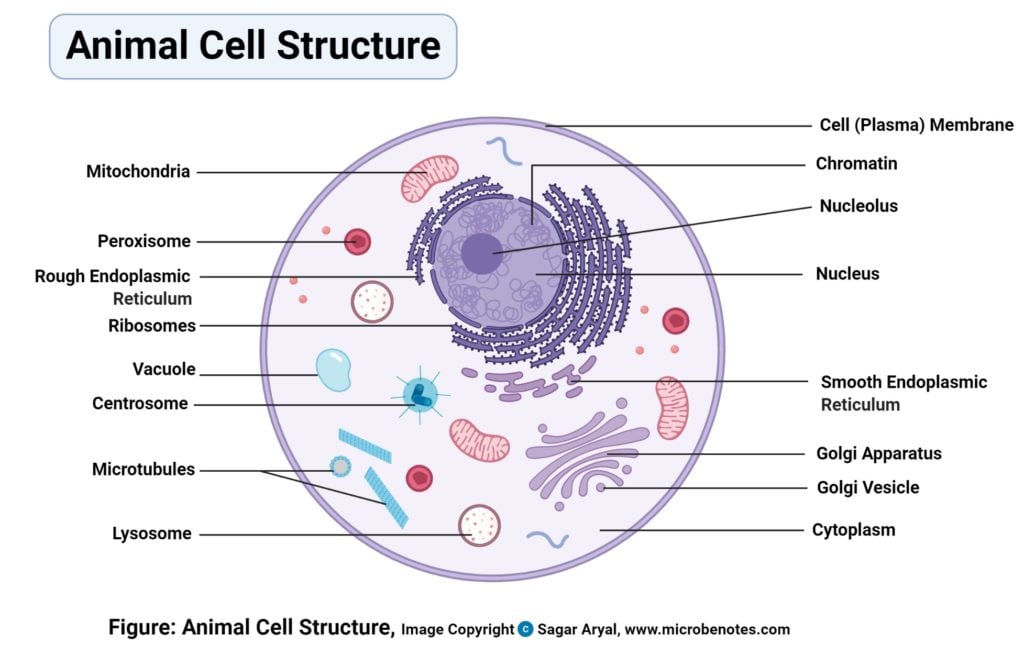Which Of The Following Is Found In An Animal Cell But Not In A Plant Cell Brainly
Plants and animals are made upwards of millions of cells and these cells accept several similarities and differences.
Because that they are both eukaryotic cells, which means they have a truthful nucleus, that is enclosed and separated from other organelles by a nuclear membrane, is a crucial factor that defines their modes of multiplication. They have like reproduction processes of mitosis and meiosis, using their Deoxyribonucleic acid that is housed past the cell nucleus.

Figure created with biorender.com
What are constitute cells and animal cells?
They are also both membrane-bound with several cell organelles in common performing the same if non similar mechanisms to maintain and command the cells' normal part. These organelles include the nucleus, Golgi bodies, endoplasmic reticulum, ribosomes, mitochondria, cytoskeleton, peroxisomes, and the jail cell membrane.
They likewise undergo cellular respiration, which performs processes of free energy production used to grow the prison cell and maintain its normal functions.
Despite having all these similarities they have several differences equally well.
Structurally, establish and animal cells are very like because they are both eukaryotic cells. They both contain membrane-bound organelles such as the nucleus, mitochondria, endoplasmic reticulum, Golgi apparatus, lysosomes, and peroxisomes. Both also incorporate similar membranes, cytosol, and cytoskeletal elements. The functions of these organelles are extremely similar between the ii classes of cells (peroxisomes perform boosted complex functions in institute cells having to do with cellular respiration). All the same, the few differences that exist betwixt plants and animals are very significant and reflect a divergence in the functions of each prison cell.

Figure created with biorender.com
Found cells can be larger than creature cells. The normal range for an animal cell varies from ten to 30 micrometers while that for a constitute cell stretches from x to 100 micrometers. Beyond size, the chief structural differences between plant and creature cells prevarication in a few additional structures found in plant cells. These structures include chloroplasts, the cell wall, and vacuoles.
Animate being jail cell vs Plant prison cell (Table form)
| Characteristic | Animal prison cell | Institute jail cell |
| Definition | Animal cells are too the basic functional unit of life for animals constituting all cell organelles that perform a diverseness of functions to back up the animals' metabolisms. | Plant cells are bones functional units of plants constituting all cell organelles performing a multifariousness of functions that support the plants' metabolisms. |
| Size and shape | Animal cells are generally smaller than plant cells with their cells ranging from 10-30um in length. Animal cell shapes and sizes vary profoundly from irregular shapes to round shapes, nigh defined past the function they perform. | Institute cells are larger than creature cells with the prison cell size ranging from 10um-100um in length. Institute cells are like in shape with most cells existence rectangular or cube-shaped. |
| Cell wall | They lack the cell wall but possess a plasma (jail cell) membrane, which performs the function of support and protection of the cell from external impairment. It also plays a major function in selective permeability allowing in and outflow of nutrient molecules, h2o, and other cell elements. | They have both a cell wall that is made upward of jail cell membrane and cellulose. The cell wall is, a rigid membrane matrix found on the surface of all plant cells whose primary role is to protect the cell and its content. |
| Plasma membrane | They have a plasma membrane that is a thin flexible membrane, which acts as a protective covering for the animal prison cell. It also has selective permeability. | The presence of the plasma membrane made up of cellulose, just beneath the cell wall allows selective permeability of cell contents into and out of the cell cytoplasm. |
| Cytoplasm | Information technology houses all the jail cell organelles. | It houses most of the cell organelles |
| Ribosomes | They are present and are used for poly peptide synthesis and genetic coding of the protein, amino acid sequences. | They are present and are used for poly peptide synthesis and cellular repair mechanisms. |
| Endoplasmic reticulum | They are present in 2 types: rough endoplasmic and smooth endoplasmic reticulum | They are present, in ii types; rough and smooth endoplasmic reticulum |
| Lysosomes | Beast cells have lysosomes, that comprise digestive enzymes to suspension down cellular macromolecules. | Plant cells rarely contain lysosomes as the institute vacuole and the Golgi bodies handle molecule degradation of waste cellular products. |
| Vacuoles | Brute cells may take many minor vacuoles, a lot smaller than the plant cell. | Found cells have a big central vacuole that can occupy upward to xc% of the cell's book. |
| Nucleus | Present and information technology lies at the centre of the cell | Nowadays and it lies on the side of the cell |
| Nucleolus | Present in the nucleus | Present in the nucleus |
| Centrioles | They are present with their major function involving the assistance of the cell division process. | They are absent-minded in plant cells |
| Peroxisomes | They are nowadays in the cytoplasm. They perform the oxidation mechanisms for specific biomolecules and they help in the synthesis of plasmalogen lipids. | They are present in the cell cytoplasm functioning as jail cell oxidizers for cellular molecules, synthesis of lipids, and recycling carbon from phosphoglycolate during photorespiration. |
| Microfilaments and microtubules | They are present functioning to give support to the cell cytoskeleton, send materials beyond the cytoplasm into and out of the nucleus. They are also involved d in cytokinesis. | They are present, to give cytoskeletal support, transportation of molecules across the cytoplasm and the nucleus and they play a major role in cytokinesis. |
| Cytoskeletons | Present and its major functions include creating a network that organizes the cell components and maintains the cell shape. | They have a cytoskeleton that maintains the plant cell shape, supports the cell cytoplasm and maintains the cell's structural organization. |
| Cytosol | Nowadays and its where all the cell organelles are suspended | Nowadays, it's where most of the jail cell organelles are suspended. |
| Microvilli | They are present in the intestinal lining to increase the surface area for the absorption of food. | Absent in plant cells. |
| Granules | Present | Present |
| Cilia and Filaments | Present; they let motion of cells or part of the jail cell, for example, swimming of the sperm to the ova. | Absent-minded in plants |
| Plastids | Absent-minded | Present; they give pigmentation colour to the plants and likewise facilitate trapping of low-cal free energy used for photosynthesis. |
| Plasmodesmata | Absent | Present; they facilitate the communication and transport of materials across establish cells. |
| Golgi bodies | They have larger and fewer Golgi bodies with their major function being to procedure and bundle protein and lipid macromolecules as they are being synthesized. | They have smaller but more Golgi bodies with their major office being a modification, processing, sorting, and packaging proteins for cellular secretion. |
| Synthesis of cellular nutrients | They cannot synthesize amino acids, vitamins, and coenzymes. | They can synthesize amino acids, vitamins, and vitamins. |
| Cytokinesis | It takes place past constriction | It takes place in the prison cell plates |
| Osmosis in a hypotonic solution | They take in water molecules by osmosis and hands burst when placed in hypotonic solution because of the lack of a cell wall | They absorb h2o molecules by osmosis but they practise not burst in a hypotonic solution due to the presence of a cell wall. |
References and Sources
- 3% – https://www.bioexplorer.net/difference-between-plant-and-beast-cells.html/
- 2% – https://brainly.com/question/11566088
- 2% – https://answersdrive.com/what-is-the-departure-between-plant-and-animal-cells-7203906
- 2% – https://answersdrive.com/what-are-the-similarities-between-beast-and-found-cells-7292357
- 1% – https://www.thoughtco.com/what-is-a-plant-jail cell-373384
- ane% – https://www.thoughtco.com/vacuole-organelle-373617
- one% – https://world wide web.thoughtco.com/differences-betwixt-mitosis-and-meiosis-373390
- ane% – https://www.thoughtco.com/animal-cells-vs-plant-cells-373375
- 1% – https://world wide web.differencebetween.com/deviation-between-pits-and-plasmodesmata/
- 1% – https://biologywise.com/institute-cell-structure-role
- 1% – https://biologydictionary.net/osmosis/
- <i% – https://www.youtube.com/sentry?v=AcrqIxt8am8
- <1% – https://www.youtube.com/watch?v=_Th0bsASzmM
- <1% – https://nrcca.cals.cornell.edu/soilFertilityCA/CA1/CA1_print.html
- <ane% – https://biologywise.com/smoothen-endoplasmic-reticulum-function
- <1% – https://biologywise.com/constitute-cell-vs-brute-cell
- <1% – https://biologywise.com/found-cell-organelles
- <1% – https://biodifferences.com/difference-between-plant-cell-and-fauna-cell.html
- <1% – https://answersdrive.com/what-is-the-difference-betwixt-the-plasma-membrane-and-the-cell-membrane-1493230
- <1% – http://www.biology4kids.com/files/cell_nucleus.html
Source: https://microbenotes.com/plant-cell-vs-animal-cell/
Posted by: marcottefrientor.blogspot.com

0 Response to "Which Of The Following Is Found In An Animal Cell But Not In A Plant Cell Brainly"
Post a Comment